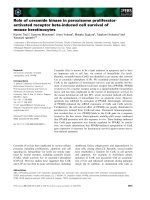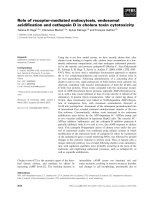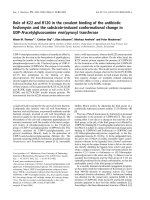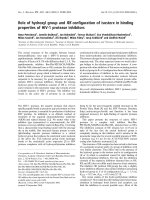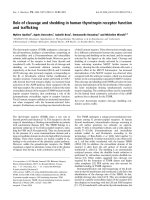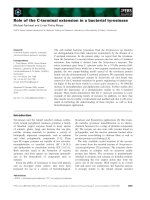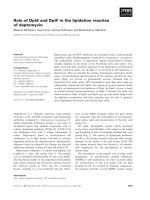Báo cáo khoa học: "Role of Verbs in Document Analysis" pot
Bạn đang xem bản rút gọn của tài liệu. Xem và tải ngay bản đầy đủ của tài liệu tại đây (688.71 KB, 7 trang )
Role of Verbs in Document Analysis
Judith Klavans* and Min-Yen Kan**
Center for Research on Information Access* and Department of Computer Science**
Columbia University
New York, NY 10027, USA
Abstract
We present results of two methods for assessing
the event profile of news articles as a function
of verb type. The unique contribution of this
research is the focus on the role of verbs, rather
than nouns. Two algorithms are presented and
evaluated, one of which is shown to accurately
discriminate documents by type and semantic
properties, i.e. the event profile. The initial
method, using WordNet (Miller et al. 1990),
produced multiple cross-classification of arti-
cles, primarily due to the bushy nature of the
verb tree coupled with the sense disambiguation
problem. Our second approach using English
Verb Classes and Alternations (EVCA) Levin
(1993) showed that monosemous categorization
of the frequent verbs in WSJ made it possible to
usefully discriminate documents. For example,
our results show that articles in which commu-
nication verbs predominate tend to be opinion
pieces, whereas articles with a high percentage
of agreement verbs tend to be about mergers or
legal cases. An evaluation is performed on the
results using Kendall's ~ We present convinc-
ing evidence for using verb semantic classes as
a discriminant in document classification. 1
1
Motivation
We present techniques to characterize document
type and event by using semantic classification
of verbs. The intuition motivating our research
is illustrated by an examination of the role of
1The authors acknowledge
earlier implementations by
James Shaw, and very valuable discussion from Vasileios
Hatzivassiloglou, Kathleen McKeown
and Nina
Wa-
cholder. Partial funding for this project was provided
by NSF award #IRI-9618797 STIMULATE:
Generating
Coherent
Summaries of On-Line Documents:
Combining
Statistical and Symbolic Techniques (co-PI's McKeown
and
Klavans), and
by the
Columbia University Center
for Research on Information Access.
680
nouns and verbs in documents. The listing be-
low shows the ontological categories which ex-
press the fundamental conceptual components
of propositions, using the framework of Jack-
endoff (1983). Each category permits the for-
mation of a wh-question, e.g. for
[THING]
"what
did you buy?" can be answered by the noun
"a fish". The wh-questions for [ACTION] and
[EVENT] can only be answered by verbal con-
structions, e.g. in the question "what did you
do?", where the response must be a verb, e.g.
jog, write, fall,
etc.
[TH,NG] [DmECT,ON] [ACTION]
[eLAtE] [MANNER] [EVENT]
[AMO,NT]
The distinction in the ontological categories
of nouns and verbs is reflected in information ex-
traction systems. For example, given the noun
phrases
fares
and
US Air
that occur within a
particular article, the reader will know what the
story is about, i.e.
fares
and
US Air.
However,
the reader will not know the
[EVENT],
i.e. what
happened to the
fares
or to
US Air.
Did airfare
prices
rise, fall
or
stabilize?
These are the verbs
most typically applicable to prices, and which
embody the event.
1.1 Focus on the Noun
Many natural language analysis systems focus
on nouns and noun phrases in order to identify
information on who, what, and where. For ex-
ample, in summarization, Barzilay and Elhadad
(1997) and Lin and Hovy (1997) focus on multi-
word noun phrases. For information extraction
tasks, such as the DARPA-sponsored Message
Understanding Conferences (1992), only a few
projects use verb phrases (events), e.g. Ap-
pelt et al. (1993), Lin (1993). In contrast, the
named entity task, which identifies nouns and
noun phrases, has generated numerous projects
as evidenced by a host of papers in recent con-
ferences, (e.g. Wacholder et al. 1997, Palmer
and Day 1997, Neumann et al. 1997). Although
rich information on nominal participants, ac-
tors, and other entities is provided, the named
entity task provides no information on what
happened in the document, i.e. the event or
action. Less progress has been made on ways
to utilize verbal information efficiently. In ear-
lier systems with stemming, many of the verbal
and nominal forms were conflated, sometimes
erroneously. With the development of more so-
phisticated tools, such as part of speech taggers,
more accurate verb phrase identification is pos-
sible. We present in this paper an effective way
to utilize verbal information for document type
discrimination.
1.2 Focus on the Verb
Our initial observations suggested that both oc-
currence and distribution of verbs in news arti-
cles provide meaningful insights into both ar-
ticle type and content. Exploratory analysis
of parsed Wall Street Journal data 2 suggested
that articles characterized by movement verbs
such as drop, plunge, or fall have a different
event profile from articles with a high percent-
age of communication verbs, such as report, say,
comment, or complain. However, without asso-
ciated nominal arguments, it is impossible to
know whether the
[THING]
that drops refers to
airfare prices or projected earnings.
In this paper, we assume that the set of verbs
in a document, when considered as a whole, can
be viewed as part of the conceptual map of the
events and action in a document, in the same
way that the set of nouns has been used as a
concept map for entities. This paper reports on
two methods using verbs to determine an event
profile of the document, while also reliably cat-
egorizing documents by type. Intuitively, the
event profile refers to the classification of an ar-
ticle by the kind of event. For example, the
article could be a discussion event, a reporting
event, or an argument event.
To illustrate, consider a sample article from
WSJ of average length (12 sentences in length)
with a high percentage of communication verbs.
The profile of the article shows that there are
19 verbs: 11 (57%) are communication verbs,
including add, report, say, and tell. Other
2Penn TreeBank (Marcus et al. 1994) from the Lin-
guistic Data Consortium.
681
verbs include be skeptical, carry, produce, and
close. Representative nouns include Polaroid
Corp., Michael Ellmann, Wertheim Schroder
Co., Prudential-Bache, savings, operating "re-
sults, gain, revenue, cuts, profit, loss, sales, an-
alyst, and spokesman.
In this case, the verbs clearly contribute in-
formation that this article is a report with
more opinions than new facts. The prepon-
derance of communication verbs, coupled with
proper noun subjects and human nouns (e.g.
spokesman, analyst) suggest a discussion arti-
cle. If verbs are ignored, this fact would be
overlooked. Matches on frequent nouns like gain
and loss do not discriminate this article from
one which announces a gain or loss as breaking
news; indeed, according to our results, a break-
ing news article would feature a higher percent-
age of motion verbs rather than verbs of com-
munication.
1.3 On Genre Detection
Verbs are an important factor in providing an
event profile, which in turn might be used in cat-
egorizing articles into different genres. Turning
to the literature in genre classification, Biber
(1989) outlines five dimensions which can be
used to characterize genre. Properties for dis-
tinguishing dimensions include verbal features
such as tense, agentless passives and infinitives.
Biber also refers to three verb classes: private,
public, and suasive verbs. Karlgren and Cut-
ting (1994) take a computationally tractable set
of these properties and use them to compute a
score to recognize text genre using discriminant
analysis. The only verbal feature used in their
study is present-tense verb count. As Karlgren
and Cutting show, their techniques are effective
in genre categorization, but they do not claim
to show how genres differ. Kessler et al. (1997)
discuss some of the complexities in automatic
detection of genre using a set of computation-
ally efficient cues, such as punctuation, abbrevi-
ations, or presence of Latinate suffixes. The tax-
onomy of genres and facets developed in Kessler
et al. is useful for a wide range of types, such
as found in the Brown corpus. Although some
of their discriminators could be useful for news
articles (e.g. presence of second person pronoun
tends to indicate a letter to the editor), the in-
dicators do not appear to be directly applicable
to a finer classification of news articles.
News articles can be divided into several stan-
dard categories typically addressed in journal-
ism textbooks. We base our article category
ontology, shown in lowercase, on Hill and Breen
(1977), in uppercase:
1. FEATURE STORIES : feature;
2. INTERPRETIVE STORIES: editorial, opinion,
report;
3. PROFILES;
4. PRESS RELEASES: announcements, mergers, legal cases;
5. OBITUARIES;
6. STATISTICAL INTERPRETATION: posted earnings;
7. ANECDOTES;
8. OTHER: poems.
The goal of our research is to identify the
role of verbs, keeping in mind that event profile
is but one of many factors in determining text
type. In our study, we explored the contribu-
tion of verbs as one factor in document type dis-
crimination; we show how article types can be
successfully classified within the news domain
using verb semantic classes.
2 Initial Observations
We initially considered two specific categories of
verbs in the corpus: communication verbs and
support verbs. In the WSJ corpus, the two most
common main verbs are say, a communication
verb, and be, a support verb. In addition to
say, other high frequency communication verbs
include report, announce, and state. In journal-
istic prose, as seen by the statistics in Table 1,
at least 20% of the sentences contain commu-
nication verbs such as say and announce; these
sentences report point of view or indicate an
attributed comment. In these cases, the subor-
dinated complement represents the main event,
e.g. in "Advisors announced that IBM stock
rose 36 points over a three year period," there
are two actions: announce and rise. In sen-
tences with a communication verb as main verb
we considered both the main and the subor-
dinate verb; this decision augmented our verb
count an additional 20% and, even more im-
portantly, further captured information on the
actual event in an article, not just the commu-
nication event. As shown in Table 1, support
verbs, such as go ("go out of business") or get
("get along"), constitute 30%, and other con-
tent verbs, such as fall, adapt, recognize, or vow,
make up the remaining 50%. If we exclude all
support type verbs, 70% of the verbs yield in-
formation in answering the question "what hap-
pened?" or "what did X do?"
3 Event Profile: WordNet and EVCA
Since our first intuition of the data suggested
that articles with a preponderance of verbs of
682
Verb Type Sample Verbs %
communication say, announce 20%
support have, get, go, 30%
remainder abuse, claim, offer, 50%
Table 1: Approximate Frequency of verbs by
type from the Wall Street Journal (main and
selected subordinate verbs, n = 10,295).
a certain semantic type might reveal aspects of
document type, we tested the hypothesis that
verbs could be used as a predictor in provid-
ing an event profile. We developed two algo-
rithms to: (1) explore WordNet (WN-Verber)
to cluster related verbs and build a set of verb
chains in a document, much as Morris and Hirst
(1991) used Roget's Thesaurus or like Hirst and
St. Onge (1998) used WordNet to build noun
chains; (2) classify verbs according to a se-
mantic classification system, in this case, us-
ing Levin's (1993) English Verb Classes and
Alternations (EVCA-Yerber) as a basis. For
source material, we used the manually-parsed
Linguistic Data Consortium's Wall Street Jour-
nal (WSJ) corpus from which we extracted main
and complement of communication verbs to test
the algorithms on.
Using WordNet. Our first technique was
to use WordNet to build links between verbs
and to provide a semantic profile of the docu-
ment. WordNet is a general lexical resource in
which words are organized into synonym sets,
each representing one underlying lexical concept
(Miller et al. 1990). These synonym sets - or
synsets - are connected by different semantic
relationships such as hypernymy (i.e. plunging
is a way of descending), synonymy, antonymy,
and others (see Fellbaum 1990). The determina-
tion of relatedness via taxonomic relations has a
rich history (see Resnik 1993 for a review). The
premise is that words with similar meanings will
be located relatively close to each other in the
hierarchy. Figure 1 shows the verbs cite and
post, which are related via a common ancestor
inform, , let know.
The WN-Verber tool. We used the hypernym
relationship in WordNet because of its high cov-
erage. We counted the number of edges needed
to find a common ancestor for a pair of verbs.
Given the hierarchical structure of WordNet,
the lower the edge count, in principle, the closer
the verbs are semantically. Because WordNet
common ancestor
inform let know
testifY~~ou~c~
abduct cite attest
report post sound
Figure 1: Taxonomic Relations for cite and post
in WordNet.
allows individual words (via synsets) to be the
descendent of possibly more than one ances-
tor, two words can often be related by more
than one common ancestor via different paths,
possibly with the same relationship (grandpar-
ent and grandparent, or with different relations
(grandparent and uncle).
Results from WN-Verber. We ran all arti-
cles longer than 10 sentences in the WSJ cor-
pus (1236 articles) through WN-Verber. Output
showed that several verbs - e.g. go, take, and
say - participate in a very large percentage of
the high frequency synsets (approximate 30%).
This is due to the width of the verb forest in
WordNet (see Fellbaum 1990); top level verb
synsets tend to have a large number of descen-
dants which are arranged in fewer generations,
resulting in a flat and bushy tree structure. For
example, a top level verb synset, inform, ,
give information, let know has over 40 children,
whereas a similar top level noun synset, entity,
only has 15 children. As a result, using fewer
than two levels resulted in groupings that were
too limited to aggregate verbs effectively. Thus,
for our system, we allowed up to two edges to in-
tervene between a common ancestor synset and
each of the verbs' respective synsets, as in Fig-
ure 2.
acceptable•
] i• unacceptable•
2 a 2 0 •2 vl • 1
1
4 °
• •3
v~ v~ • • vl
i vl v2 • •
v2 •
v2 •
Figure 2: Configurations for relating verbs in
our system.
In addition to the problem of the flat na-
ture of the verb hierarchy, our results from
WN-Verber are degraded by ambiguity; similar
effects have been reported for nouns. Verbs with
differences in high versus low frequency senses
caused certain verbs to be incorrectly related;
683
for example, have and drop are related by the
synset meaning "to give birth" although this
sense of drop is rare in WSJ.
The results of NN-Verber in Table 2 reflect
the effects of bushiness and ambiguity. The five
most frequent synsets are given in column 1; col-
umn 2 shows some typical verbs which partici-
pate in the clustering; column 3 shows the type
of article which tends to contain these synsets.
Most articles (864/1236 = 70%) end up in the
top five nodes. This illustrates the ineffective-
ness of these most frequent WordNet synset to
discriminate between article types.
Synset Sample Article types
Verbs (listed in
order)
in
Synset
Act have, relate,
announcements, editori-
(interact,
act to- give,
tell als,
features
gether,
)
Communicate give,
get, in- announcements, editori-
(communicate, form, tell als,
features, poems
intercommunicate,
)
Change have,
modify, poems, editorials, an-
(change)
take nouncements, features
Alter
convert, announcements, poems,
(alter, change) make, get editorials
Inform inform, ex- announcements, poems,
(inform, round on, plain, de-
features
)
scribe
Table 2: Frequent synsets and article types.
Evaluation
using Kendall's Tau. We
sought independent confirmation to assess the
correlation between two variables' rank for
WN-Verber results. To evaluate the effects of
one synset's frequency on another, we used
Kendall's tau (r) rank order statistic (Kendall
1970). For example, was it the case that verbs
under the synset act tend not to occur with
verbs under the synset think? If so, do ar-
ticles with this property fit a particular pro-
file? In our results, we have information about
synset frequency, where each of the 1236 arti-
cles in the corpus constitutes a sample. Ta-
ble 3 shows the results of calculating Kendall's
r with considerations for ranking ties, for all
(10) = 45 pairing combinations of the top 10
most frequently occurring synsets. Correlations
can range from -1.0 reflecting inverse correla-
tion, to +1.0 showing direct correlation, i.e. the
presence of one class increases as the presence
of the correlated verb class increases. A T value
of 0 would show that the two variables' values
are independent of each other.
Results show a significant positive correlation
between the synsets. The range of correlation
is from .850 between the
communication
verb
synset
(give, get, inform, )
and the act verb
synset
(have, relate, give, )
to .238 between
the think verb synset
(plan, study, give, )
and
the change state verb synset
(fall, come, close,
).
These correlations show that frequent synsets
do not behave independently of each other and
thus confirm that the WordNet results are not
an effective way to achieve document discrim-
ination. Although the WordNet results were
not discriminatory, we were still convinced that
our initial hypothesis on the role of verbs in
determining event profile was worth pursuing.
We believe that these results are a by-product
of lexical ambiguity and of the richness of the
WordNet hierarchy. We thus decided to pur-
sue a new approach to test our hypothesis, one
which turned out to provide us with clearer and
more robust results.
act com chng alter infm exps thnk I judg I trnf
~tate
.407 .296 .672 .461 .286 .269 .238 I .355 .268
;rnsf
.437 .436 .251 .436 .251 .404 .369 .359
iudge
.444 .414 .435 .450 .340 .348 .427
.~xprs .444 .414 .435 .397 .322 .432
;hink
.444 .414 .435 .397 .398
~nfrm
.614 ,649 .341 .380
~lter .501 .454 .619
Table 3: Kendall's T for frequent WordNet
synsets.
Utilizing EVCA. A different approach to
test the hypothesis was to use another semantic
categorization method; we chose the semantic
classes of Levin's EVCA as a basis for our next
analysis. 3 Levin's seminal work is based on the
time-honored observation that verbs which par-
ticipate in similar syntactic alternations tend to
share semantic properties. Thus, the behavior
of a verb with respect to the expression and in-
terpretation of its arguments can be said to be,
in large part, determined by its meaning. Levin
has meticulously set out a list of syntactic tests
(about 100 in all), which predict membership in
no less than 48 classes, each of which is divided
into numerous sub-classes. The rigor and thor-
oughness of Levin's study permitted us to en-
code our algorithm, EVCA-Verber, on a sub-set
3Strictly speaking, our classification is based on
EVCA. Although many of our classes are precisely de-
fined in terms of EVCA tests, we did impose some ex-
tensions. For example, support verbs are not an EVCA
category.
of the EVCA classes, ones which were frequent
in our corpus. First, we manually categorized
the 100 most frequent verbs, as well as 50 addi-
tional verbs, which covers 56% of the verbs by
token in the corpus. We subjected each verb to
a set of strict linguistic tests, as shown in Ta-
ble 4 and verified primary verb usage against
the corpus.
Verb Class
(sample verbs)
Communication
(add, say, an-
nounce,
)
Motion
(rise, fall, decline,
)
Agreement
(agree, accept, con-
cur,
)
Argument
(argue, debate,
,
)
Causative
(cause)
Sample Test
(1)
Does this involve a transfer of
ideas?
(2) X verbed "something."
(1) *"X
verbed without
moving".
(1) "They
verbed to join forces."
(2)
involves more than one participant.
(1) "They verbed (over) the issue."
(2)
indicates conflicting views.
(3)
involves more than one participant.
(1) X verbed Y
(to happen/happened).
(2) X brings about a
change in
Y.
Table 4: EVCA verb class test
Results from EVCA-Verber. In order to be
able to compare article types and emphasize
their differences, we selected articles that had
the highest percentage of a particular verb class
from each of the ten verb classes; we chose five
articles from each EVCA class, yielding a to-
tal of 50 articles for analysis from the full set
of 1236 articles. We observed that each class
discriminated between different article types as
shown in Table 5. In contrast to Table 2, the ar-
ticle types are well discriminated by verb class.
For example, a concentration of communica-
tion class verbs
(say, report, announce, )
in-
dicated that the article type was a general an-
nouncement of short or medium length, or a
longer feature article with many opinions in the
text. Articles high in motion verbs were also
announcements, but differed from the commu-
nication ones, in that they were commonly post-
ings of company earnings reaching a new high
or dropping from last quarter. Agreement and
argument verbs appeared in many of the same
articles, involving issues of some controversy.
However, we noted that articles with agreement
verbs were a superset of the argument ones in
that, in our corpus, argument verbs did not ap-
pear in articles concerning joint ventures and
mergers. Articles marked by causative class
verbs tended to be a bit longer, possibly re-
flecting prose on both the cause and effect of
684
a particular action. We also used EVCA-Verber
to investigate articles marked by the absence of
members of each verb class, such as articles lack-
ing any verbs in the motion verb class. However,
we found that absence of a verb class was not
discriminatory.
Verb Class
(sample verbs)
Communication
(add, say, announce,
)
Motion
(rise, fall, decline, )
Agreement
(agree, accept, concur,
)
Argument
(argue, indicate, contend,
.,.)
Causative
(cause)
Article types
(listed by frequency)
issues, reports, opinions, editorials
posted earnings, announcements
mergers, legal cases, transactions
(without buying and selling)
legal cases, opinions
opinions, feature, editorials
Table 5: EVCA-based verb class results.
Evaluation of EVCA verb classes. To
strengthen the observations that articles domi-
nated by verbs of one class reflect distinct arti-
cle types, we verified that the verb classes be-
haved independently of each other. Correlations
for EVCA classes are shown in Table 6. These
show a markedly lower level of correlation be-
tween verb classes than the results for WordNet
synsets, the range being from .265 between mo-
tion and aspectual verbs to 026 for motion
verbs and agreement verbs. These low values
of T for pairs of verb classes reflects the inde-
pendence of the classes. For example, the com-
munication and experience verb classes are
weakly correlated; this, we surmise, may be due
to the different ways opinions can be expressed,
i.e. as factual quotes using communication
class verbs or as beliefs using experience class
verbs.
comun motion agree argue exp I aspect~ cause
appear
.122 .076 .077 .072 .182 [ .112 J .037
cause
.093 .083 .000 .000 .073 .096
aspect
.246 .265 .034 .110 .189
exp
.260 .130 .054 .054
argue
.162 .045 .033
argree
.071 026
Table 6: Kendall's r for EVCA based verb
classes.
4 Results and Future Work.
Basis for WordNet and EVCA compari-
son. This paper reports results from two ap-
proaches, one using WordNet and other based
685
on EVCA classes. However, the basis for com-
parison must be made explicit. In the case
of WordNet, all verb tokens (n = 10K) were
considered in all senses, whereas in the case of
EVCA, a subset of less ambiguous verbs were
manually selected. As reported above, we cov-
ered 56% of the verbs by token. Indeed, when
we attempted to add more verbs to EVCA cat-
egories, at the 59% mark we reached a point of
difficulty in adding new verbs due to ambigu-
ity, e.g. verbs such as
get.
Thus, although our
results using EVCA are revealing in important
ways, it must be emphasized that the compar-
ison has some imbalance which puts WordNet
in an unnaturally negative light. In order to ac-
curately compare the two approaches, we would
need to process either the same less ambiguous
verb subset with WordNet, or the full set of all
verbs in all senses with EVCA. Although the re-
sults reported in this paper permitted the vali-
dation of our hypothesis, unless a fair compari-
son between resources is performed, conclusions
about WordNet as a resource versus EVCA class
distinctions should not be inferred.
Verb Patterns. In addition to considering
verb type frequencies in texts, we have observed
that verb distribution and patterns might also
reveal subtle information in text. Verb class dis-
tribution within the document and within par-
ticular sub-sections also carry meaning. For ex-
ample, we have observed that when sentences
with movement verbs such as
rise
or
fall
are fol-
lowed by sentences with
cause
and then a telic
aspectual verb such as
reach,
this indicates that
a value rose to a certain point due to the actions
of some entity. Identification of such sequences
will enable us to assign functions to particular
sections of contiguous text in an article, in much
the same way that text segmentation program
seeks identify topics from distributional vocab-
ulary (Hearst, 1994; Kan et al., 1998). We can
also use specific sequences of verbs to help in
determining methods for performing semantic
aggregation of individual clauses in text gener-
ation for summarization.
Future Work. Our plans are to extend the
current research in terms of verb coverage and
in terms of article coverage. For verbs, we plan
to (1) increase the verbs that we cover to include
phrasal verbs; (2) increase coverage of verbs
by categorizing additional high frequency verbs
into EVCA classes; (3) examine the effects of
increased coverage on determining article type.
For articles, we plan to explore a general parser
so we can test our hypothesis on additional texts
and examine how our conclusions scale up. Fi-
nally, we would like to combine our techniques
with other indicators to form a more robust sys-
tem, such as that envisioned in Biber (1989) or
suggested in Kessler et al. (1997).
Conclusion. We have outlined a novel ap-
proach to document analysis for news articles
which permits discrimination of the event pro-
file of news articles. The goal of this research is
to determine the role of verbs in document anal-
ysis, keeping in mind that event profile is one of
many factors in determining text type. Our re-
sults show that Levin's EVCA verb classes pro-
vide reliable indicators of article type within the
news domain. We have applied the algorithm to
WSJ data and have discriminated articles with
five EVCA semantic classes into categories such
as features, opinions, and announcements. This
approach to document type classification using
verbs has not been explored previously in the
literature. Our results on verb analysis coupled
with what is already known about NP identi-
fication convinces us that future combinations
of information will be even more successful in
categorization of documents. Results such as
these are useful in applications such as passage
retrieval, summarization, and information ex-
traction.
References
D. Appelt, J. Hobbs, J. Bear, D. Isreal, and M. Tyson.
1993. Fastus: A finite state processor for information
extraction from real world text. In
Proceedings of the
13th International Joint Conference on Artificial In-
telligence (LICAI),
Chambery, l~rance.
Regina Barzilay and Michael Elhadad. 1997. Using lex-
ical chains for text summarization. In
Proceedings
of the Intelligent Scalable Text Summarization Work-
shop (ISTS'97), ACL,
Madrid, Spain.
Douglas Biber. 1989. A typology of english texts.
Lan-
guage,
27:3-43.
Christiane Fellbaum. 1990. English verbs as a semantic
net.
International Journal of Lexicography,
3(4):278-
301.
Maarti A. Hearst. 1994. Multi-paragraph segmentation
of expository text. In
Proceedings of the 32th Annual
Meeting of the Association of Computational Linguis-
tics.
Evan Hill and John J. Breen. 1977.
Reporting ~ Writ-
ing the News.
Little, Brown and Company, Boston,
Massachusetts.
Graeme Hirst and David St-Onge. 1998. Lexical chains
as representations of context for the detection and cor-
686
rection of malapropisms.
WordNet: An electronic lex-
ical database and some of its applications.
Ray Jackendoff. 1983.
Semantics and Cognition.
MIT
University Press, Cambridge, Massachusetts.
Min-Yen Kan, Judith L. Klavans, and Kathleen R. McK-
eown. 1998. Linear segmentation and segment rele-
vance. Unpublished Manuscript.
Jussi Karlgren and Douglass Cutting. 1994. Recogniz-
ing text genres with simple metrics using discrimi-
nant analysis. In
Fifteenth International Conference
on Computational Linguistics (COLING '9~),
Kyoto,
Japan.
Maurice G. Kendall. 1970.
Rank Correlation Methods.
Griffin, London, England, 4th edition.
Brent Kessler, Geoffrey Nunberg, and Hinrich Schiitze.
1997. Automatic detection of text genre. In
Proceed-
ings of the 35th Annual Meeting of the Association of
Computational Linguistics,
Madrid, Spain.
Beth Levin. 1993.
English Verb Classes and Alterna-
tions.
University of Chicago Press, Chicago, Ohio.
Chin-Yew Lin and Eduard Hovy. 1997. Identifying top-
ics by position. In
Proceedings of the 5th A CL Confer-
ence on Applied Natural Language Processing,
pages
283-290, Washington, D.C., April.
Dekang Lin. 1993. University of Manitoba: Descrip-
tion of the NUBA System as Used for MUC-5. In
Proceedings of the Fifth Conference on Message Un-
derstanding MUC-5,
pages 263-275, Baltimore, Mary-
land. ARPA.
Mitch Marcus et al. 1994.
The Penn Treebank: Anno-
tating Predicate Argument Structure.
ARPA Human
Language Technology Workshop.
George A. Miller, Richard Beckwith, Christiane Fell-
baum, Derek Gross, and Katherine J. Miller.
1990. Introduction to WordNet: An on-line lexical
database.
International Journal of Lexicography (spe-
cial issue),
3(4):235-312.
Jane Morris and Graeme Hirst. 1991. Lexical coher-
ence computed by thesaural relations as an indicator
of the structure of text.
Computational Linguistics,
17(1):21-42.
1992.
Message Understanding Conference MUC.
Giinter Neumann, Rolf Backofen, Judith Baur, Marcus
Becker, and Christian Braun. 1997. An information
extraction core system for real world german text pro-
cessing. In
Proceedings of the 5th A CL Conference on
Applied Natural Language Processing,
pages 209-216,
Washington, D.C., April.
David D. Palmer and David S. Day. 1997. A statistical
profile of the named entity task. In
Proceedings of
the 5th A CL Conference on Applied Natural Language
Processing,
pages 190-193, Washington, D.C., April.
Philip Resnik. 1993.
Selection and Information: A
Class-Based Approach to Lexical Relationships.
Ph.D.
thesis, Department of Computer and Information Sci-
ence, University of Pennsylvania.
Nina Wacholder, Yael Ravin, and Misook Choi. 1997.
Disambiguation of proper names in text. In
Proceed-
ings of the 5th ACL Conference on Applied Natural
Language Processing,
volume 1, pages 202-209, Wash-
ington, D.C., April.


